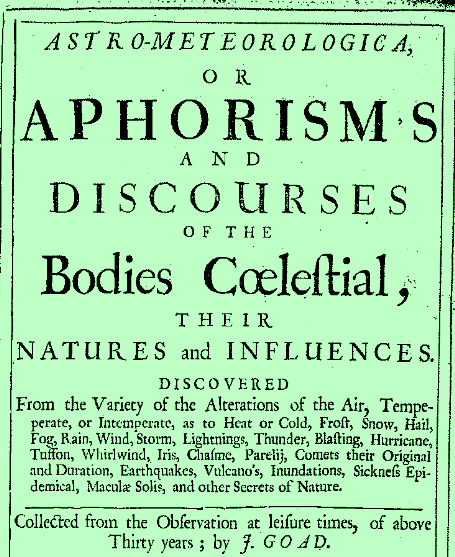Lightning, Thunder, Whirlwind
I will tell you a secret, which is that sometimes I dive into texts like this for their soothing qualities. The busy, crammed fashion of the book acts as a psychological processing machine. The seventeenth-century scientific project and its adjacent texts are perfect for this, with their non-stop small ‘facts’ and accretion of examples. I have been studying them for years, and I read them for fun. Instead of novels, often.
This is a fantastic example. You could process any feeling with this book. Even the title is so extremely capacious:
ASTRO-METEROLOGICA, or APHORISM'S [sic] and DISCOURSES of the Bodies Cœlestial, their NATURES and INFLUENCES. Discovered From the Variety of the Alterations of the Air, Temperate, or Intemperate, as to Heat or Cold, Frost, Snow, Hail, Fog, Rain, Wind, Storm, Lightnings, Thunder, Blasting, Hurricane, Tusson, Whirlwind, Iris, Chasme, Parelij, Comets their Original and Duration, Earthquakes, Vulcano's, Inundations, Sickness Epidemical, Maculæ Solis, and other Secrets of Nature.
Inside the book there is everything I'd hope for: listings about mermaids, and a full suite of information about how each celestial influence created events on earth:
A° 1574. July 9. At the Isle of Thanet, A Whale shot himself on Shore, ho. 6 p. Length 22 yards. Any Man might have crept into his Mouth.
A° 1582. Aug. 12. Lightning, Thunder, Whirlwind, with hail fashioned like Spur rowls, two or three Inches about in Norfolk, beat the Corn flat to the Ground, rent up many Trees, and shiver'd them into pieces, or writh'd them like Withs; the Top of Hendon Church was lifted up, 5 Webs of Lead ruffled up together like so much Linen Cloth.
The roof of the church ruffled up like linen cloth. A dead whale so big that a man might have crept into his mouth! It is perhaps unscholarly (or environmentally uncaring) to revel in, and even feast on, the language of these entries, but I have been thinking about that whale for weeks.
And also there are longer passages. This is from the section about meteors, in which the author sets out Aristotle’s theory of earthly exhalations:
hence comes the little diminutive sparkling of the Candle, the spitting of the Fire from under the Embers, the puffing and murmuring of the flaming Coal, the concretion of Sparks and Knots in the Snuff (Lucernarum fungi), the Adhesion of Embers to the Hearth, of the Live coal to the Pot-side; all betokening some Alteration of the Moisture, which betrays it self by concretion of things contiguous, or by that little sparkling at the approach of the Flame, which at other times burns quiet, and cals for no Observation.
The diminutive sparkling of the candle, concretion of sparks and knots in the snuff. Why have one example when you can have fifty, a hundred? I also read a book about serpents on Sunday, which I may write about here soon. That is my answer to ‘how are you?’

